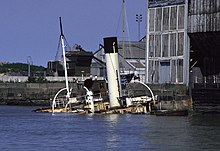PSJohn H Amos
 John H Amosin 1988
| |
| History | |
|---|---|
| Name | John H Amos |
| Owner | Tees Conservancy Commissioners |
| Port of registry |
|
| Ordered | 1931 |
| Builder | Bow, McLachlan & Co,Paisley, Scotland |
| Cost | £18,500 |
| Yard number | 497 |
| Launched | 26 December 1930 |
| In service | 1931 |
| Homeport | Chatham,Kent |
| Status | Non-operational, on barge |
| General characteristics | |
| Type | Tugboat |
| Tonnage | 202 tons |
| Length | 110 ft (34 m) |
| Beam |
|
| Installed power |
|
| Propulsion | 2 diagonalcompound engineswith Bremme valve gear |
| Speed | 13 knots (24 km/h) |
| Crew | 6 |
John H Amosis apaddlewheeltugboatbuilt inScotlandin 1931. The last paddlewheel tug built for private owners, now owned by theMedway Maritime Trust.She is one of only two surviving British-built paddle tugs, the other beingEppleton Hallpreserved at theSan Francisco Maritime National Historical ParkinSan Francisco,California.[1]
Construction[edit]
John H Amoswas commissioned for theRiver TeesConservancy Commissioners and built byBow, McLachlan and CompanyLtd. ofPaisley,Scotland.[2]She was named to honour of the Secretary to the Commissioners, John Hetherington Amos who died in 1934. Before completion Bow, McLachlan & Co. went intoliquidationand its yard was taken over byNational Shipbuilders Securities(NSS). NSS finished the work by using materials that were already available in the yard, which resulted in a variation to design specification: some parts were therefore better, while others were worse.
On first steaming, it was discovered that theboilersused could not supply enough steam for the diagonalcompound engines,meaning she could only reach 11 knots instead of the intended 13 knots.[citation needed]She was completed in 1931 but the Tees Conservancy Commissioners did not accept her for another two years before remedial work was completed to bring her up to design specification.
Operations[edit]
Between 1940 and 1967, the period covered by the Daily Towage Records atTeesside Archives,she took barges to dredgers and the dumping grounds, towed dredgers which had no propulsion of their own, and transferred the crews. She had a crew of six:master,mate,two engineers (one for each engine), a stoker and a deck hand.
Said to have been an inefficient boat as a tug, she was given a certificate for 144 passengers to make her more useful. In the mouth of the River Tees was pier known as theFifth Buoy Light:when approaching the river, ships had the two lights in line they knew they were on the right course. In the middle of the structure was a building described as adance hall,which belonged to the Tees Commissioners, which theJohn H Amoswas used to transport passengers to.
There were regular incidents ofalcoholsmugglingon the Tees, and in 1959 the boat was arrested for smuggling, having towed some off-shore barges into the river. The master was changed for a period, and the boat taken to court, although no individual was eventually charged.
Like all paddle steamers[citation needed]she had a shallow draught. When towing barges, they were always lashed alongside, and she would normally use only one paddle. Although wide, the configuration allowed efficient operation in shallow draught water, and hence why she worked for so long.
First period of preservation[edit]
Withdrawn from service in 1967, two years later she was presented by theTees and Hartlepool Ports Authorityto theCounty Borough of Teessidefor "The People of Cleveland." In December 1971 she was moved fromMiddlesbroughtoStocktonCorporation Quay, with a plan using trainees to convert the tug into a floating museum.
1976–99[edit]

As a result of UK Government reorganisation of funding, the youth project based restoration was withdrawn and the boat put up for sale. TwoRiver Thamesbased businessmen, who operated the UK's only steam powered tug fleet, purchased the boat for £3,500. After a dispute within the council at the sale, she left Stockton watched by a crowd of 400 to the accompaniment ofRule Britanniaplayed by a localbrass bandon 4 March 1976.
RenamedHeroshe became part of the fleet of International Towing Ltd (ITL), based at Gun Wharf,Chatham Dockyard.By the end of 1976, the partners split the ITL fleet, andJohn H Amosmoved from Gun Wharf to Milton Creek, and thenFaversham Creek.
WhenHMSEndurancereturned from theFalklands War,theRoyal Navyoffered the newly formed Medway Maritime Trust two buoys on which to moor their two boats.
Second period of preservation[edit]

John H Amoshence moved to Anchor Wharf, Historic Dockyard. When the Dockyard Trust acquired the submarineHMSOcelot,John H Amoswas moved to a new berth at which she sat on a submerged lump of concrete. Resultantly holed, she sank at her mooring. Happily, the dockyard trust then agreed she could be moored on a free slipway.
In November 1999,John H Amoswas listed as part of theNational Historic Fleetas a vessel of "Pre-eminent National Significance" and among the most worthy vessels for preservation.
In 2001 the ownership was transferred to the Medway Maritime Trust, with funding from theScience Museum.Restoration grant aid was given from theHeritage Lottery Fund,National Historic Ships,[3]and Rochester Bridge Trust.
Due to be slipped in 2004, timing and contractual delays meant she stayed on the slipway. In 2006, the trust acquiredPortal Narvik,the remains of the formerTank Landing ShipHMSNarvik.After earning monies to pay for the lift ofJohn H Amos,in May 2009 one of the largest sea cranes in Europe, the GPS Atlas, liftedJohn H AmosontoPortal Narvik.[2]
The pair are now moored alongside, in Chatham Docks, where the vessel is to be cleaned and comprehensively recorded, awaiting restoration funds. In 2008, Chatham-born artistBilly Childishmade several paintings of theJohn H Amos,one of which shows the tug safely aboard thePortal Narvikpontoon, moored mid-river.
References[edit]
- ^"Eppleton Hall".Retrieved24 February2009.
- ^abEwens, Graeme (4 April 2008)."Amos Saved from a Watery Grave".maritimejournal.com.Retrieved7 October2015.
- ^"John H Amos".nationalhistoricships.org.Retrieved7 October2015.
